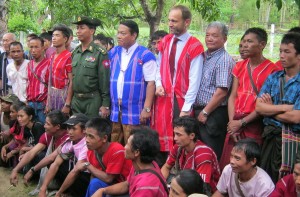Peace and National Reconciliation (65 found)
Burma Peace Funds Must Do No Harm
 By Paul Sein Twa
By Paul Sein Twa
In the past few months, various media reports have quoted some concerns and opinions of KESAN regarding the ongoing peace process in Burma. This statement clarifies and expands upon these issues.
Our perspective on the peace process and peace funds
Sustainable peace is the long-term vision of Karen people. That vision incorporates rule of law, the protection of human rights, democratic governance, security of livelihood and equitable access to natural resources and essential services. We are not there yet.
Peace funds can be an important tool for building a culture of peace in Burma. Well managed peace funds can serve as positive instruments to advance shared multi-ethnic and government agendas for peace. However, peace funds must contribute to addressing deep rooted and structural obstacles to realizing peace in the country and strengthen community decision making processes to identify the priorities of ethnic people. The effective management of peace funds includes maximum transparency, support for a shared framework for peace, inclusive and meaningful consultation with a wide-range of non-state actors, multi-party dialogues and clear monitoring and accountability mechanisms. What we have witnessed so far is that the current peace fund process falls short of these good practices – and standards […]
Investors’ Haste to Build Big Dams is Undermining Fragile Peace Process in Karen State
The push by investors to proceed with large dams in Karen areas of Burma is threatening to undermine ongoing ceasefire negotiations between the Karen National Union (KNU) and the Burmese government.
Increased Burma Army security around dam sites and blatant disregard for concerns of impacted communities are heightening tensions, and throwing into doubt the government’s sincerity in conducting ceasefire talks […]
• • •Opium Cultivation Surging in Constituency of Burma’s New Ruling Party
A new briefing paper by the Palaung Women’s Organization (PWO) exposes a dramatic increase in opium cultivation in Burma’s northern Shan State in the constituency of a drug lord elected into the new military-backed parliament […]
• • •China Speeds Ahead with Myitsone Dam Despite Civil War in Northern Burma
Seven hundred Chinese laborers are working day and night shearing off hilltops, laying tunnels, and building embankments at the Myitsone, the source of Burma’s Irrawaddy River, in a race to complete the country’s largest dam on schedule despite ongoing […]
• • •Hydropower Dams Fuelling Conflict in Burma
Recent fighting near the Dapein and Shweli hydropower dams in northern Burma shows how the buildup of Burma Army troops to secure deeply unpopular Chinese dam projects is fuelling conflict.
Fighting broke out between the Burma Army and the Kachin Independence Organization (KIO) last week at the Dapein No. 1 and 2 dams, which are being constructed by China’s state-owned Datang Company […]
• • •








 All posts
All posts